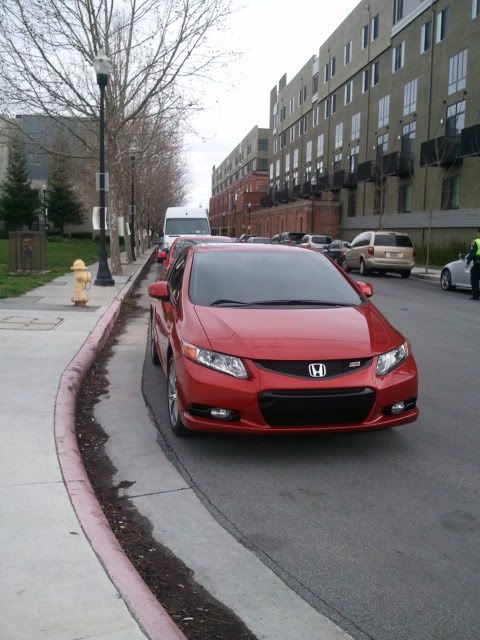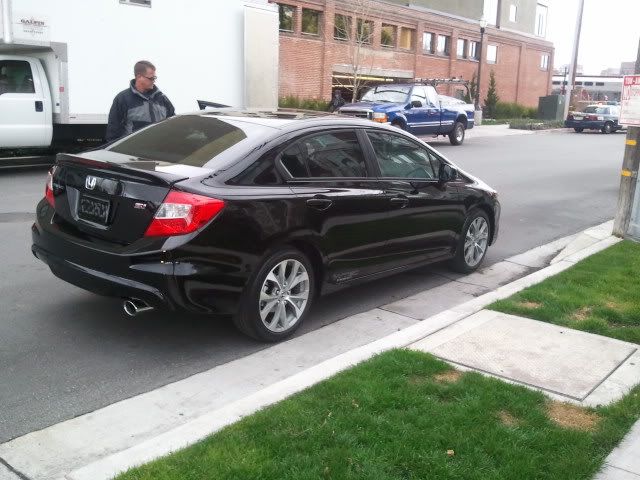9th Gen Civic Forum : 2012 Honda Civic Forums - 9th Generation
CAR Middle East has done it again – we’re the 1st ones in the world to bring you the 1st pictures of the next generation of the Civic sedan, completely naked of all camouflage!
We snapped these twin silver prototypes during a spell of early morning hot weather testing. Apart from a few missing ‘H’ badges, this is the Civic you can expect to see in UAE showrooms next year. As our pictures show, it’s very similar in dimensions to the existing GCC model with a comparable midsection ; the glasshouse, doors and wing mirrors look to be unchanged.
![Image]()
The front fascia is where the big news is – gone are the old model’s undulating curves over pronounced arches and drooping headlamps, replaced by a sharper, wedgier front end and what looks to be a wider lower air intake. Optional foglight cutouts are on either side, disguised by heavy lashings of pesky silver gaffer tape. That tape is also present at the base of the A-pillar and the C-pillar as well over the rear bumper, so we suspect there may be a few stylistic surprises yet to come.
Out front, the earlier striking chrome moustache framing the central Honda emblem is now a fairly generic three-bar grille, while the angular headlamps look to be the same as the ones found on US market models. Note the character line that starts from the end of the front lights, spears off and extends all the way to the arrow-shaped rear cluster. The latter has lost its former GT-R-ish four circular brake lamps in favour of a squishy hexagonal look that’s vaguely reminiscent of its baby City brother. A slim, almost vestigial spoiler caps the pert rear end.
The unique “folding-hands” wiper arrangement looks to have been retained atop the steeply raked – and vast, start saving up for tint folks! – windshield, but the old printed antenna seems to have been given the heave-ho in favour of a traditional (and probably cheaper) stubby aerial mounted BMW-style above the rear windshield. Suitably-chunky 16-inch 5–spoke alloys round off the major exterior changes.
![Image]()
Inside, the 2-tier dashboard has been retained, raked even more steeply toward the driver. The steering wheel is still a 3-spoke affair but it now sports 2 4 way controllers on each side instead of the earlier toggles. Gone is the knob-based temperature and fanspeed controls, with a slew of buttons taking their place. That’s below what looks like a double-DIN touch-based navigation system – tuners of the world rejoice, your favourite rolling music platform still lives.
On the far left of the dashboard, you’ll notice a single, very large green button that says “Eco”. On overseas models, pressing this switch sets the engine, transmission and cooling functions to maximum efficiency, although judging by our hot climes, it’s unlikely to get much use here. We didn’t get a chance to look under the hood, but our sources suggest that the engine being tested is a 1.5 litre unit, which if true is significantly smaller than the existing 1.8 140bhp 1. Hello fuel efficiency, goodbye acceleration.
Overall, outside of the few details we couldn’t discern, it looks to be a blander, more generic version of a car that should be at the very heartland of Honda thinking. The earlier, space-age Civic landed like a atomic bomb in the compact car market, sending arch-rivals like Toyota and Nissan scurrying back to the drawing board to bring out more exciting-looking sedans.
Now Honda looks to be losing faith in its daring design direction, delivering a cheese-wedge sedan that could easily be mistaken for – whisper it – 1 of the equally wedgy Koreans that are flooding out of South East Asia. Or perhaps it’s merely a reflection of these austere times where sobriety is a virtue. Either way: we want our old Honda back.
![Image]()
CAR Middle East has done it again – we’re the 1st ones in the world to bring you the 1st pictures of the next generation of the Civic sedan, completely naked of all camouflage!
We snapped these twin silver prototypes during a spell of early morning hot weather testing. Apart from a few missing ‘H’ badges, this is the Civic you can expect to see in UAE showrooms next year. As our pictures show, it’s very similar in dimensions to the existing GCC model with a comparable midsection ; the glasshouse, doors and wing mirrors look to be unchanged.

The front fascia is where the big news is – gone are the old model’s undulating curves over pronounced arches and drooping headlamps, replaced by a sharper, wedgier front end and what looks to be a wider lower air intake. Optional foglight cutouts are on either side, disguised by heavy lashings of pesky silver gaffer tape. That tape is also present at the base of the A-pillar and the C-pillar as well over the rear bumper, so we suspect there may be a few stylistic surprises yet to come.
Out front, the earlier striking chrome moustache framing the central Honda emblem is now a fairly generic three-bar grille, while the angular headlamps look to be the same as the ones found on US market models. Note the character line that starts from the end of the front lights, spears off and extends all the way to the arrow-shaped rear cluster. The latter has lost its former GT-R-ish four circular brake lamps in favour of a squishy hexagonal look that’s vaguely reminiscent of its baby City brother. A slim, almost vestigial spoiler caps the pert rear end.
The unique “folding-hands” wiper arrangement looks to have been retained atop the steeply raked – and vast, start saving up for tint folks! – windshield, but the old printed antenna seems to have been given the heave-ho in favour of a traditional (and probably cheaper) stubby aerial mounted BMW-style above the rear windshield. Suitably-chunky 16-inch 5–spoke alloys round off the major exterior changes.

Inside, the 2-tier dashboard has been retained, raked even more steeply toward the driver. The steering wheel is still a 3-spoke affair but it now sports 2 4 way controllers on each side instead of the earlier toggles. Gone is the knob-based temperature and fanspeed controls, with a slew of buttons taking their place. That’s below what looks like a double-DIN touch-based navigation system – tuners of the world rejoice, your favourite rolling music platform still lives.
On the far left of the dashboard, you’ll notice a single, very large green button that says “Eco”. On overseas models, pressing this switch sets the engine, transmission and cooling functions to maximum efficiency, although judging by our hot climes, it’s unlikely to get much use here. We didn’t get a chance to look under the hood, but our sources suggest that the engine being tested is a 1.5 litre unit, which if true is significantly smaller than the existing 1.8 140bhp 1. Hello fuel efficiency, goodbye acceleration.
Overall, outside of the few details we couldn’t discern, it looks to be a blander, more generic version of a car that should be at the very heartland of Honda thinking. The earlier, space-age Civic landed like a atomic bomb in the compact car market, sending arch-rivals like Toyota and Nissan scurrying back to the drawing board to bring out more exciting-looking sedans.
Now Honda looks to be losing faith in its daring design direction, delivering a cheese-wedge sedan that could easily be mistaken for – whisper it – 1 of the equally wedgy Koreans that are flooding out of South East Asia. Or perhaps it’s merely a reflection of these austere times where sobriety is a virtue. Either way: we want our old Honda back.






























































































